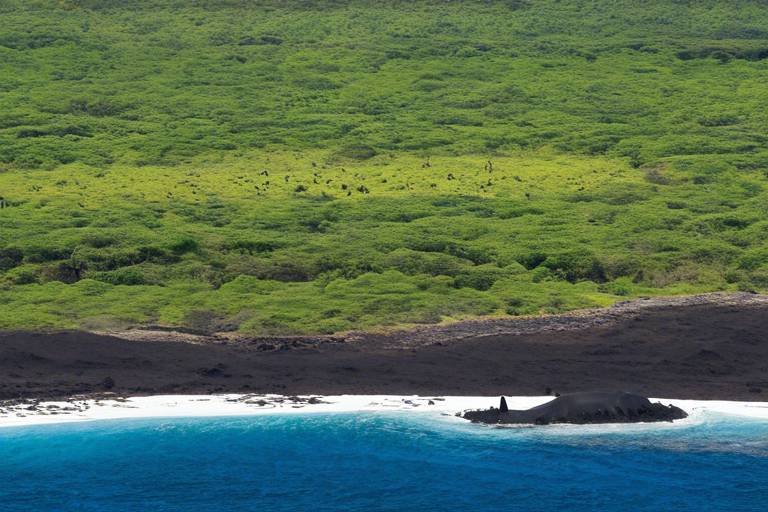Reducing Your Carbon Footprint in the Galápagos Archipelago
When it comes to preserving the pristine beauty of the Galápagos Archipelago, reducing your carbon footprint plays a crucial role in ensuring the sustainability of this unique ecosystem. By understanding the concept of carbon footprint and its impact on the environment in this biodiverse region, you can take proactive steps to minimize your environmental impact and contribute to the conservation efforts in the Galápagos.
Carbon footprint refers to the total amount of greenhouse gases, particularly carbon dioxide, emitted directly or indirectly by human activities. In the Galápagos Archipelago, a fragile ecosystem renowned for its endemic species and marine life, excessive carbon emissions can lead to detrimental effects such as ocean acidification, coral bleaching, and habitat destruction. By reducing our carbon footprint, we can help protect the delicate balance of this natural paradise.
One of the key areas where individuals can make a significant impact is through their transportation choices. Opting for eco-friendly modes of transportation such as electric vehicles, bicycles, or walking not only reduces carbon emissions but also allows you to immerse yourself in the stunning landscapes of the Galápagos Islands without harming the environment.
Furthermore, adopting energy conservation techniques can further lower your carbon footprint in the Galápagos. Utilizing renewable energy sources like solar or wind power, practicing energy-efficient habits such as turning off lights when not in use, and minimizing water consumption all contribute to a more sustainable lifestyle that benefits the local ecosystem.
When it comes to accommodation, choosing sustainable lodging options that prioritize eco-friendly practices can significantly reduce your environmental impact. From hotels powered by renewable energy to eco-lodges that promote conservation initiatives, there are various choices available that align with your commitment to lowering your carbon footprint in the Galápagos.
Proper waste management is another crucial aspect of reducing your carbon footprint in the Galápagos Archipelago. By following responsible waste disposal practices, recycling materials, and supporting local recycling programs, you can help minimize pollution and preserve the natural beauty of the islands for future generations to enjoy.
Supporting local conservation efforts is essential for mitigating the carbon footprint in the Galápagos. Whether through volunteering for habitat restoration projects, donating to wildlife conservation organizations, or participating in community clean-up initiatives, every contribution makes a difference in safeguarding the unique biodiversity of this extraordinary region.
Education and awareness programs play a vital role in promoting sustainable practices and reducing carbon emissions in the Galápagos Archipelago. By educating tourists and locals about the importance of environmental conservation, we can foster a culture of stewardship that values the preservation of the Galápagos’ natural heritage.
Government policies and regulations also play a significant role in shaping sustainable practices in the Galápagos. By adhering to environmental regulations, supporting conservation laws, and advocating for responsible tourism practices, we can collectively work towards a greener future for the Galápagos Archipelago.
Community engagement and collaboration are key components of reducing the carbon footprint in the Galápagos. By fostering partnerships between local communities, businesses, and conservation organizations, we can create a network of support dedicated to implementing eco-friendly initiatives and protecting the fragile ecosystem of the Galápagos Islands.
Understanding Carbon Footprint
When it comes to preserving the unique and fragile ecosystem of the Galápagos Archipelago, understanding and reducing your carbon footprint plays a crucial role. Your carbon footprint refers to the total amount of greenhouse gases, primarily carbon dioxide, that are generated by your actions and activities. In the Galápagos, a delicate balance exists, and any excess carbon emissions can have detrimental effects on the environment, marine life, and wildlife that call this archipelago home.
Reducing your carbon footprint begins with awareness and knowledge of how your daily choices impact the environment. In the Galápagos Archipelago, where biodiversity thrives, every action counts. From the transportation you choose to the energy you consume, each decision can either contribute to or mitigate carbon emissions. By understanding the sources of carbon footprint and their implications, you can make informed choices that align with sustainability and conservation efforts.
Transportation Choices
When it comes to reducing your carbon footprint in the Galápagos Archipelago, one of the key aspects to consider is your transportation choices. The mode of transportation you opt for can significantly impact the environment in this unique ecosystem. By selecting eco-friendly transportation options, you can contribute to the conservation efforts in the Galápagos Islands and minimize the carbon emissions that result from travel.
One of the most sustainable transportation choices in the Galápagos is utilizing electric vehicles or bicycles for getting around the islands. These modes of transport produce zero emissions, helping to preserve the pristine environment of the archipelago. Additionally, walking or hiking to explore the natural beauty of the Galápagos not only reduces carbon emissions but also allows you to immerse yourself fully in the breathtaking landscapes.
Another eco-conscious way to travel within the Galápagos is by supporting local businesses that prioritize sustainability in their operations. Opting for tour operators and transportation services that have implemented green practices and eco-friendly initiatives can make a positive difference in reducing the overall carbon footprint of your journey.
By choosing to sail on eco-friendly boats or yachts for inter-island travel in the Galápagos, you can further lower your environmental impact. These vessels are equipped with advanced technologies that minimize fuel consumption and emissions, ensuring a more sustainable travel experience while exploring the diverse marine life of the archipelago.
Ultimately, the transportation choices you make during your visit to the Galápagos play a crucial role in preserving this fragile ecosystem for future generations. By prioritizing eco-friendly modes of travel and supporting sustainable transportation initiatives, you can contribute to the conservation efforts and help protect the natural wonders of the Galápagos Archipelago.
Energy Conservation Techniques
Energy conservation techniques play a crucial role in reducing the carbon footprint in the Galápagos Archipelago. By implementing sustainable practices and utilizing renewable energy sources, individuals and businesses can significantly minimize their environmental impact on these unique islands. One effective technique is the adoption of solar panels to harness the abundant sunlight in the region and generate clean electricity. Solar energy not only reduces reliance on fossil fuels but also contributes to long-term energy savings and sustainability.
Another essential method for energy conservation is the optimization of energy-efficient appliances and lighting systems. By upgrading to appliances with high energy efficiency ratings and using LED bulbs, residents and businesses can lower their electricity consumption and subsequently decrease carbon emissions. Additionally, implementing smart energy management systems can further enhance energy conservation efforts by monitoring and regulating energy usage in real-time.
Furthermore, promoting energy conservation through awareness campaigns and educational programs can inspire individuals to adopt sustainable practices in their daily lives. Educating the local community and tourists about the importance of energy efficiency and conservation not only raises awareness but also fosters a culture of environmental responsibility. By encouraging behavioral changes and promoting the benefits of energy conservation, a collective effort towards reducing the carbon footprint in the Galápagos can be achieved.
Sustainable Accommodation
When looking for accommodation in the Galápagos Archipelago, opting for sustainable options can significantly contribute to reducing your carbon footprint. Sustainable accommodation focuses on minimizing environmental impact through eco-friendly practices and initiatives. These lodgings are designed to operate efficiently, conserve resources, and support local communities.
By choosing sustainable accommodation, visitors can actively participate in promoting environmental conservation and responsible tourism. These establishments often utilize renewable energy sources such as solar power, practice water conservation, and implement waste management strategies to reduce their overall carbon footprint.
Additionally, sustainable accommodations in the Galápagos Archipelago prioritize the use of locally sourced materials, support local businesses, and engage in conservation efforts within the community. Staying at these eco-friendly lodgings not only benefits the environment but also contributes to the preservation of the unique ecosystem of the Galápagos Islands.
Waste Management Strategies
Waste management plays a crucial role in reducing the environmental impact on the delicate ecosystem of the Galápagos Archipelago. Proper disposal and recycling methods are essential to maintain the pristine beauty of this unique destination. By implementing effective waste management strategies, visitors and residents alike can contribute to the preservation of this natural wonder.
One effective waste management strategy is the segregation of waste at its source. By separating recyclable materials from general waste, individuals can ensure that valuable resources are diverted from landfills and put to good use through recycling processes. This simple yet impactful practice significantly reduces the amount of waste that ends up polluting the environment.
Furthermore, promoting composting practices can help in minimizing organic waste that would otherwise contribute to greenhouse gas emissions. Composting not only reduces the volume of waste but also enriches the soil, supporting the growth of vegetation and maintaining the ecological balance of the Galápagos Islands.
Engaging in beach clean-up initiatives is another effective waste management strategy that directly combats marine pollution. By participating in organized clean-up events or simply picking up litter while exploring the beaches, individuals can prevent harmful waste from endangering marine life and disrupting the fragile marine ecosystems of the Galápagos.
Moreover, raising awareness about the importance of responsible waste management through educational campaigns and community outreach programs is key to fostering a culture of sustainability in the Galápagos. By educating both locals and tourists about the impact of improper waste disposal, we can inspire collective action towards a cleaner and greener environment.
Supporting Local Conservation Efforts
Supporting local conservation efforts in the Galápagos Archipelago is crucial for preserving the unique biodiversity of this pristine region. By actively participating in conservation projects and initiatives, visitors and residents alike can make a significant impact in reducing the carbon footprint and protecting the delicate ecosystems of the islands.
One effective way to support local conservation efforts is to engage in volunteer programs organized by various organizations and conservation groups operating in the Galápagos. These programs offer opportunities to participate in habitat restoration, wildlife monitoring, and community outreach projects, allowing individuals to directly contribute to conservation efforts on the islands.
Furthermore, supporting local businesses that prioritize sustainability and environmental stewardship is another way to make a positive impact. By choosing to patronize eco-friendly accommodations, tour operators, and restaurants that follow responsible practices, visitors can help promote a culture of conservation and sustainability in the Galápagos.
Education plays a key role in fostering a sense of environmental responsibility among both tourists and locals. By participating in guided tours, workshops, and educational programs focused on conservation and sustainability, individuals can gain a deeper understanding of the importance of protecting the fragile ecosystems of the Galápagos.
Collaborating with local conservation organizations and research institutions can also be a meaningful way to support ongoing efforts to preserve the unique flora and fauna of the Galápagos. By contributing financial resources, expertise, or volunteering time, individuals can play a vital role in advancing conservation initiatives on the islands.
Ultimately, by actively engaging in and supporting local conservation efforts, individuals can help ensure that the Galápagos Archipelago remains a beacon of biodiversity and a model for sustainable living for generations to come.
Education and Awareness Programs
Education and awareness programs play a crucial role in reducing the carbon footprint in the Galápagos Archipelago. By educating both tourists and locals about sustainable practices and the importance of environmental conservation, we can foster a culture of responsibility towards the fragile ecosystem of the islands.
One effective way to raise awareness is through interactive workshops and educational sessions conducted by local conservation organizations. These programs can highlight the impact of human activities on the environment and showcase practical steps individuals can take to minimize their carbon footprint.
Furthermore, integrating environmental education into school curriculums and community events can instill a sense of stewardship in the younger generation. By teaching children about the unique biodiversity of the Galápagos and the significance of preserving it, we are shaping future leaders committed to sustainability.
Engaging in eco-tourism activities that focus on environmental education can also be a powerful tool in spreading awareness. Guided tours led by knowledgeable naturalists can provide valuable insights into the delicate balance of the ecosystem and the importance of responsible tourism practices.
Collaborating with local businesses to promote eco-friendly initiatives and offering incentives for sustainable behaviors can further amplify the impact of education and awareness programs. By creating a supportive environment that values environmental consciousness, we can inspire positive change and a collective effort towards reducing the carbon footprint in the Galápagos Archipelago.
Government Policies and Regulations
Government policies and regulations play a crucial role in shaping sustainability efforts and reducing the carbon footprint in the Galápagos Archipelago. The local government has implemented a series of measures to protect the unique ecosystem of the islands and promote environmentally friendly practices. One of the key regulations is the strict control over visitor numbers to sensitive sites, ensuring that the delicate balance of nature is not disturbed by excessive human activity.
Additionally, the Galápagos National Park Authority has set guidelines for tour operators and visitors to follow, including rules on waste disposal, wildlife interaction, and energy conservation. These regulations aim to preserve the natural beauty of the islands and minimize the impact of tourism on the environment. Tourists are encouraged to respect the rules and regulations in place to safeguard the fragile ecosystem of the Galápagos.
Furthermore, the government has introduced incentives for businesses and individuals to adopt sustainable practices. This includes tax breaks for companies that use renewable energy sources, subsidies for eco-friendly construction projects, and support for conservation initiatives. By providing incentives for sustainable behavior, the government is driving positive change towards a greener future for the Galápagos.
In collaboration with local communities and conservation organizations, the government is actively involved in initiatives to protect endangered species, restore habitats, and raise awareness about environmental issues. These partnerships are essential in creating a unified approach towards reducing the carbon footprint in the Galápagos Archipelago. By working together, stakeholders can achieve greater impact and ensure the long-term sustainability of the islands.
Community Engagement and Collaboration
Community engagement and collaboration play a vital role in the collective effort to reduce the carbon footprint in the Galápagos Archipelago. By fostering partnerships and involving local residents, businesses, and organizations, sustainable practices can be implemented more effectively and on a larger scale.
Imagine a network of individuals and groups working together like a well-oiled machine, each contributing their unique strengths and resources towards a common goal of environmental preservation. This collaboration not only enhances the impact of individual efforts but also creates a sense of shared responsibility and ownership over the conservation of the Galápagos Islands.
Through community engagement initiatives, residents can participate in conservation projects, beach clean-ups, tree planting activities, and educational campaigns. By actively involving the local community, a sense of stewardship is instilled, leading to long-term commitment and sustainable practices that benefit both the environment and the people living in the archipelago.
Collaboration with local businesses is also crucial in promoting eco-friendly practices and reducing the carbon footprint. By supporting sustainable tourism initiatives, such as offering locally sourced products, implementing energy-efficient measures, and supporting conservation projects, businesses can contribute to the overall sustainability of the Galápagos Islands.
Furthermore, partnerships between governmental agencies, non-profit organizations, and educational institutions can lead to innovative solutions and comprehensive strategies for carbon footprint reduction. By sharing knowledge, resources, and expertise, these collaborations can drive meaningful change and inspire others to join in the effort towards a greener and more sustainable Galápagos.
Ultimately, community engagement and collaboration serve as the building blocks for a more sustainable future in the Galápagos Archipelago. By bringing together diverse stakeholders and fostering a culture of environmental responsibility, we can work towards preserving the unique biodiversity and natural beauty of this pristine ecosystem for generations to come.
Frequently Asked Questions
- What is a carbon footprint?
A carbon footprint is the total amount of greenhouse gases, specifically carbon dioxide, released into the atmosphere as a result of human activities. It is a measure of the impact individuals, organizations, and communities have on the environment in terms of carbon emissions.
- How can I reduce my carbon footprint while traveling in the Galápagos?
There are several ways to reduce your carbon footprint in the Galápagos, such as choosing eco-friendly transportation options, conserving energy, staying in sustainable accommodations, practicing proper waste management, supporting local conservation efforts, and participating in education and awareness programs.
- Why is it important to support local conservation efforts in the Galápagos?
Supporting local conservation efforts in the Galápagos is crucial for preserving the unique biodiversity of the islands and reducing the overall carbon footprint. By contributing to conservation projects, you are actively helping protect the environment and promoting sustainable practices.
- What are some eco-friendly transportation choices available in the Galápagos?
Eco-friendly transportation options in the Galápagos include walking, biking, using electric vehicles, and supporting local eco-tours that prioritize sustainability. These choices help minimize carbon emissions and reduce the environmental impact of travel in the region.
- How can I contribute to community engagement and collaboration for carbon footprint reduction in the Galápagos?
You can contribute to community engagement and collaboration by participating in local sustainability initiatives, volunteering for conservation projects, supporting eco-friendly businesses, and spreading awareness about the importance of reducing carbon footprint in the Galápagos.
Galápagos Archipelago, Carbon footprint, Sustainable practices, Conservation, Environmental impact, Renewable energy, Eco-friendly transportation, Waste reduction., , Galápagos Archipelago, Carbon footprint, Sustainable practices, Conservation, Environmental impact, Renewable energy, Eco-friendly transportation, Waste reduction.,
Share this content:














Post Comment